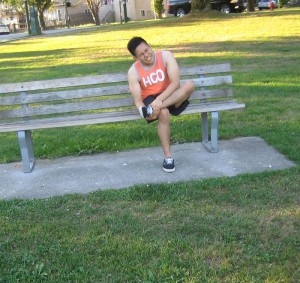Heels spurs are calcium deposits that accumulate on the underside of the heel bone. The abnormal deposit of calcium develops when the plantar fascia is disconnected from the heel. The stretching of the plantar fascia is common among individuals with flat feet and those who have high arches.
[youtube url=”https://www.youtube.com/watch?v=9c9HyJZx8bQ”]Heel spurs are common among athletes performing in activities that involve a lot of running and jumping as well as women wearing high heels. Walking barefoot on hard surfaces, running and jogging on hard surfaces, tight calf muscles, wearing poorly fitted or worn out shoes, overuse of the feet, age, obesity and those who have diabetes are at risk for developing heel spurs.
Heel spurs does not cause any symptoms but sometimes the pain can be felt in the rear of the foot while walking, running or jogging. There is pain after long periods of rest and can cause swelling and inflammation on the heels.
Treatment

- Take the prescribed over-the-counter anti-inflammatory medication such as ibuprofen to lessen the swelling and pain. Elevating the foot is also helpful with the condition.
- Apply an ice pack on the affected heel for at least 20 minutes every hour. The cold helps to lessen the inflammation and pain. Avoid applying ice directly on the skin to help prevent frostbite. Wrap the ice pack using a thin towel before it is applied on the sore area.
- Freeze a bottle of water and roll it under the foot for at least 10-15 minutes immediately after performing rigorous activities.
- Using baking soda also helps with the condition. The crystals found in baking soda helps lessen the build-up of calcium deposits at the bottom of the heel bone and also minimizes the pain and inflammation. Mix ½ teaspoon of baking soda and a few drops of water and mix to create a paste. Apply this mixture on the sore area and cover it using gauze or duct tape. Repeat this procedure at least twice every day for several days. Another way is mix a teaspoon of baking soda and 2 tablespoons of apple cider vinegar in a glass filled with warm water. Drink this solution once every day for at least 2 weeks to help balance the pH in the body.
- Mix 2-3 tablespoons of Epsom salt in a basin filled with warm water. Immerse the affected heel in the tub for at least 10-15 minutes. Gently massage the affected heel to lessen the pressure. Apply a moisturizer before going to sleep at night and repeat this procedure every day before going to bed.
- Use a heel cup or orthotic insert to minimize the pressure on the affected heel.
- Mix a teaspoon of turmeric powder in a cup of milk and then heat it in a low fire. Drink this solution at least 2 times every day to promote fast healing of the condition.
- Perform exercises that help strengthen the plantar fascia and lessen discomfort caused by the spurs. Perform stretches for the calf and plantar fascia at least 2 times a day along with foot rotation, cycling and swimming that are also beneficial to the condition.
